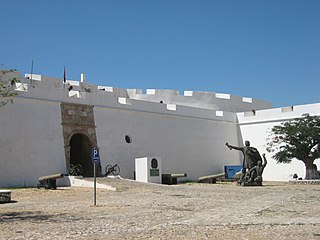Contents
This is a list of museums in Angola .
This is a list of museums in Angola .

The National Museum of Brazil is the oldest scientific institution of Brazil. It is located in the city of Rio de Janeiro, where it is installed in the Paço de São Cristóvão, which is inside the Quinta da Boa Vista. The main building was originally the residence of the House of Braganza in colonial Brazil, as the Portuguese royal family between 1808 and 1821 and then as the Brazilian imperial family between 1822 and 1889. After the monarchy was deposed, it hosted the Republican Constituent Assembly from 1889 to 1891 before being assigned to the use of the museum in 1892. The building was listed as Brazilian National Heritage in 1938 and was largely destroyed by a fire in 2018.

The Museu Nacional d'Art de Catalunya, abbreviated as MNAC, is a museum of Catalan visual art located in Barcelona, Catalonia, Spain. Situated on Montjuïc hill at the end of Avinguda de la Reina Maria Cristina, near Pl Espanya, the museum is especially notable for its outstanding collection of romanesque church paintings, and for Catalan art and design from the late 19th and early 20th centuries, including modernisme and noucentisme. The museum is housed in the Palau Nacional, a huge, Italian-style building dating to 1929. The Palau Nacional, which has housed the Museu d'Art de Catalunya since 1934, was declared a national museum in 1990 under the Museums Law passed by the Catalan Government. That same year, a thorough renovation process was launched to refurbish the site, based on plans drawn up by the architects Gae Aulenti and Enric Steegmann, who were later joined in the undertaking by Josep Benedito. The Oval Hall was reopened for the 1992 Summer Olympic Games, and the various collections were installed and opened over the period from 1995 to 2004. The museum was officially inaugurated on 16 December 2004. It is one of the largest museums in Spain.

The Museu Nacional de Arte Antiga, also known in English as the National Museum of Ancient Art, is a Portuguese national art museum located in Lisbon. With over 40,000 items spanning a vast collection of painting, sculpture, goldware, furniture, textiles, ceramics, and prints, MNAA is one of the most visited museums in Portugal.

Fortaleza de São Miguel or Saint Michael Fortress was a Portuguese fortress built in 1576 in the Ingombota District of Luanda, Angola. During Dutch rule in Angola between 1641 and 1648, the fort was known as Fort Aardenburgh.

The National Museum of Archaeology is the largest archaeological museum in Portugal and one of the most important museums devoted to ancient art found in the Iberian Peninsula. Located in Lisbon, the museum was founded in 1893 by the archaeologist José Leite de Vasconcelos. The museum is located in the western wing of the Jeronimos Monastery where the monks had their dormitory. The museum is built in the Neo-Manueline style and was officially opened in 1906.
The National Museum of Anthropology is the national museum of anthropology in Mexico.

The National Museum of Slavery is located in Morro da Cruz, Luanda, Angola.

The Museum of the Armed Forces is located in Fortaleza de São Miguel de Luanda, in the Ingombota District of Luanda, Angola.
Ingombota is one of the six urban districts that make up the municipality of Luanda, in the province of Luanda, the capital city of Angola. Ingombota is home to the central business district of Luanda, Angola. The economic, political and symbolic center of the city and the nation, it is Luanda's oldest district. The district is home to most of Luanda's prominent hotels and office towers.

Alberto Mabungulane Chissano was a Mozambican sculptor best known for his work using indigenous woods, and sculptures in rock, stone and iron. He is considered to be one of Mozambique's most important and influential artists, together with the painter Malangatana Ngwenya.

Saint Peter and Saint Paul is a painting by the Cretan-Spanish artist El Greco. The work was completed between 1590 and 1600. It is currently on display at the Museu Nacional d'Art de Catalunya, who purchased the work in 1932.

The Museu da Música is a museum in Lisbon, Portugal. The museum primarily features musical instruments; among its holdings is a 1725 Stradivarius cello once owned and played by King Luís I of Portugal (ruled 1861–1889.
The following is a timeline of the history of the city of Luanda, Angola.

The Museu Nacional de História Natural de Angola is located in the Ingombota District of the city of Luanda, Angola. It is the largest and only Museum of Natural History in Angola and one of a collection of museums in Luanda.

The Museu Nacional de Antropologia is an anthropological museum in the Ingombota District of the city of Luanda, Angola. Founded on 13 November 1976, it is a cultural and scientific institution, dedicated to the collection, research, conservation, presentation and dissemination of the Angolan cultural heritage.

Quartel Jaime Mota is a historical building in the historic city centre (Plateau) of Praia, Cape Verde. It is situated at the southern end of Avenida Andrade Corvo, near the Presidential Palace of Cape Verde. It was built between 1823 and 1826 as a military barracks. The present structure in Neo-Manueline style dates from 1872, and was further expanded and modified in the late 19th and early 20th century. After independence, it was named after Jaime Mota, a Cape Verdean militant of PAIGC who was killed in Portuguese Guinea.

The National Museum of Brazil was heavily damaged by a large fire which began about 19:30 local time on 2 September 2018. Although some items were saved, it is believed that 92.5% of its archive of 20 million items was destroyed in the fire as around 1.5 million items were stored in a separate building and were not damaged.